Last updated on December 2nd, 2011
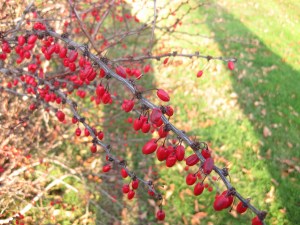
Trees, shrubs and vines which adorn themselves in bright red berries during the coldest months provide colorful accents for the winter garden, and also food for the birds, whose plumage sparkles in the frosty air. Choices for scarlet-fruited plants are seemingly unlimited. Here are the ones that attract the most birds to my own winter landscape; some of the shrubby growers even provide me with cutting material for wreaths, garlands, and house bouquets:
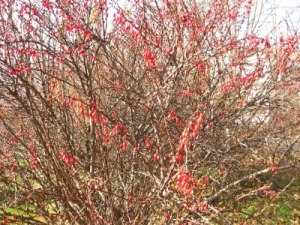 Berberis thunbergii, the red barberry, offers both food and protection for wintering birds, including finches and sparrows. Few cats are willing to encounter the shrub’s fountainous branches, which are covered with very sharp thorns. Planted as a boundary-hedge, berberis effectively deters people, too.
Berberis thunbergii, the red barberry, offers both food and protection for wintering birds, including finches and sparrows. Few cats are willing to encounter the shrub’s fountainous branches, which are covered with very sharp thorns. Planted as a boundary-hedge, berberis effectively deters people, too.
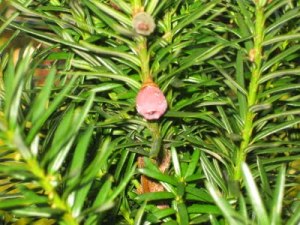 The upright-growing, evergreen yew, Taxus hicksii, makes a formal hedge for my rose garden. It’s cranberry-colored fruit is enjoyed by gackles, blackbirds, and thrushes.
The upright-growing, evergreen yew, Taxus hicksii, makes a formal hedge for my rose garden. It’s cranberry-colored fruit is enjoyed by gackles, blackbirds, and thrushes.
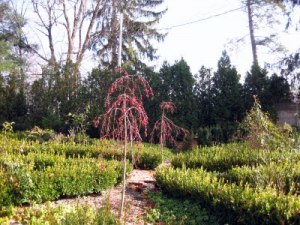 Weeping in habit, and elegant in all seasons, are the two Malus ‘Red Jade’ trees in the rose garden. During mild winters these crabapple trees hold onto their fruits until the crop of spring flowers forces them off. During more severe years, the ruby-toned jewelry is gobbled up by woodpeckers, robins, mockingbirds, catbirds, and grosbeaks.
Weeping in habit, and elegant in all seasons, are the two Malus ‘Red Jade’ trees in the rose garden. During mild winters these crabapple trees hold onto their fruits until the crop of spring flowers forces them off. During more severe years, the ruby-toned jewelry is gobbled up by woodpeckers, robins, mockingbirds, catbirds, and grosbeaks.
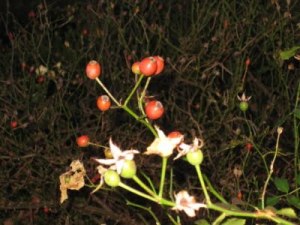 Certain roses, including ‘Carefree Delight’ offer large, colorful berries, or “hips” in winter. The hips are rich in vitamin C, and make healthy eating for grouse, juncos, bluebirds, and thrushes. I sometimes add sprigs of rosehips to winter bouquets for the house.
Certain roses, including ‘Carefree Delight’ offer large, colorful berries, or “hips” in winter. The hips are rich in vitamin C, and make healthy eating for grouse, juncos, bluebirds, and thrushes. I sometimes add sprigs of rosehips to winter bouquets for the house.
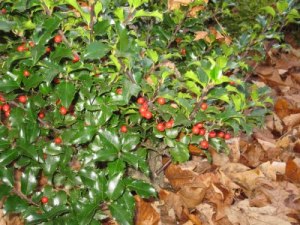 Above, the ‘Blue Princess’ holly makes a pretty red and green picture for the plot behind my potting shed. ‘Blue Prince,’ its pollinating-mate, dwells a mere 8 feet away. Holly berries are the fa-la-la of wild turkeys, mockingbirds, and woodpeckers. I’m told that skunks, racoons, foxes and bears enjoy them, too!
Above, the ‘Blue Princess’ holly makes a pretty red and green picture for the plot behind my potting shed. ‘Blue Prince,’ its pollinating-mate, dwells a mere 8 feet away. Holly berries are the fa-la-la of wild turkeys, mockingbirds, and woodpeckers. I’m told that skunks, racoons, foxes and bears enjoy them, too!
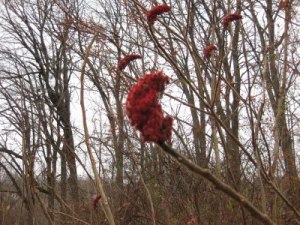 Too wild, perhaps, for the well-manicured landscape, but perfectly acceptable where garden meets woodland, is the Staghorn sumac. Its velvety, deep-red clusters of fruit keep robins and vireos from starving in late-winter. I have even seen desperate blue jays and cardinals eat them.
Too wild, perhaps, for the well-manicured landscape, but perfectly acceptable where garden meets woodland, is the Staghorn sumac. Its velvety, deep-red clusters of fruit keep robins and vireos from starving in late-winter. I have even seen desperate blue jays and cardinals eat them.
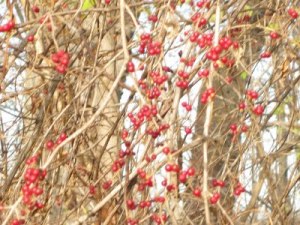 Wild honeysuckle, Lonicera, attracts blue jays, cardinals, finches and mockingbirds, who dine on its dazzling red pearls. Lonicera can look elegant in a woodland setting; I value the shrub’s vaselike form and fragrant white trumpets that emerge in summer.
Wild honeysuckle, Lonicera, attracts blue jays, cardinals, finches and mockingbirds, who dine on its dazzling red pearls. Lonicera can look elegant in a woodland setting; I value the shrub’s vaselike form and fragrant white trumpets that emerge in summer.
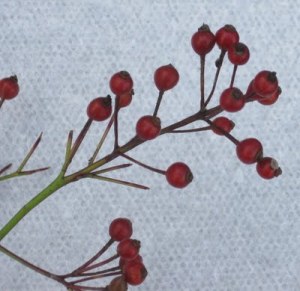 The tiny hips that appear on the wild, or “prickly” rose are adored by finches, but sadly overlooked by decorators. Sprigs of these berries make a a lovely red foil for evergreen wreaths and garlands, and also Christmassy bouquets.
The tiny hips that appear on the wild, or “prickly” rose are adored by finches, but sadly overlooked by decorators. Sprigs of these berries make a a lovely red foil for evergreen wreaths and garlands, and also Christmassy bouquets.
Do you, in your own winter yard, have a fruiting tree, shrub, or vine that attracts colorful birds? Tell me about it in the comments below.
For more gardening pleasure, sign up for Kevin’s weekly newsletter!
Related Posts:
Photo Gallery: Autumn Vistas
How to Force Freesia Bulbs
How to Overwinter Tender Herbs & Annuals

Justin says
Kevin, I'm glad you see beauty even in wild sumac. I have them on the edge of my property, too, and what a haven they are for wildlife: nesting sites in spring and summer, and food during winter. Sadly, too many gardeners seek to irradicate sumac from their properties.
Erika says
I like the idea of adding rosehips or other twigs with red berries to evergreen wreaths. Thanks for the tip!
Janis says
Well, a great many birds visit my Japanese Dogwood tree. It, too, is laden with red berries! Kevin – do you have a dogwood on your property?
Kevin Lee Jacobs says
Justin – The velvety, red clusters of Samacs are indeed very beautiful.
Erika – you are welcome!
Janis – I do not have a dogwood tree, but I do plan to get one. Maybe in the spring?
Carol says
I have hundreds of birds in my yard in winter. They go for two things here: my big, old hawthorne tree, and a pyracantha (firethorn bush). Both of these produce — guess what — red berries!
Samantha says
My neighbor has a winterberry shrub. Absolutely beautiful. It is covered with red berries, although I haven't noticed any birds hovering around it.
Kevin Lee Jacobs says
Carol – how lucky you are to have a mature hawthorn! I love pyrachantha…must find room for it!
Samantha – Winterberry is another shrub on my “wish list!”
kate says
What IS the pictured shrub (it’s wild, because we have lots of them) with the OVAL shaped deep red berries. The pointed leaves turn bright reddish pink in late fall here in New England, and the birds eat the berries, though not in droves. The dark-eyed Juncos love to hang out in the tree, and I’ve seen a male Cardinal in there too. Is it called the Red Barberry, that you mention above??
Thanks!!!
Kate
Kevin Lee Jacobs says
Hi Kate – Yes, the oval shaped fruit comes from the Red Barberry — Berberis thunbergii. (And thank you for finding this ancient post!)